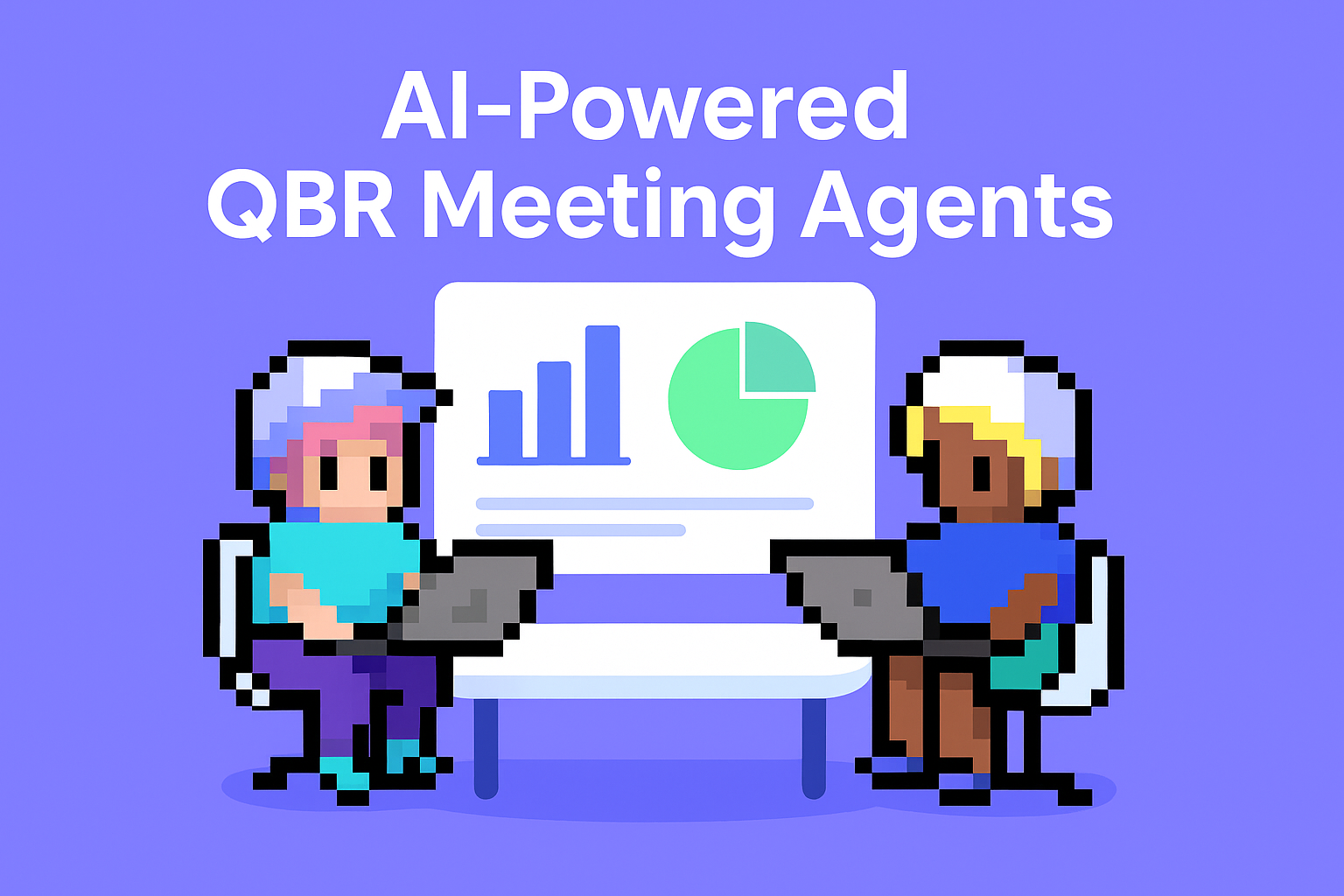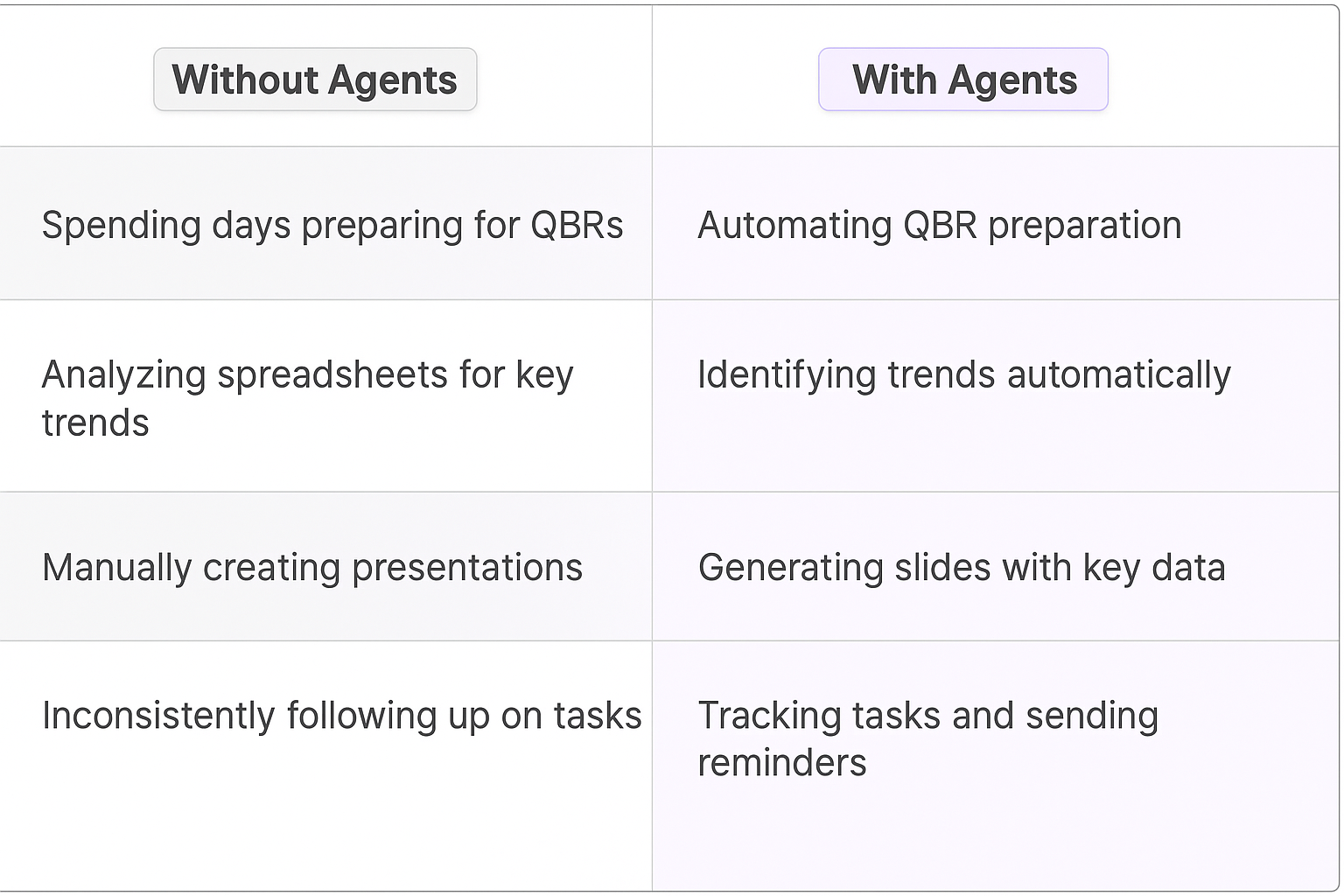
AI-powered QBR meeting agents are transforming how key account managers conduct strategic reviews. These agents automate data analysis, provide real-time insights, and streamline post-meeting follow-up, enabling managers to focus on building stronger client relationships and driving mutual success. This technology enhances meeting effectiveness, improves client satisfaction, and ultimately boosts revenue growth.
Before Meeting
Your AI agent proactively gathers and analyzes key performance indicators (KPIs), customer feedback, and market trends. It identifies potential risks and opportunities, preparing a comprehensive pre-read for both you and your client.
During Meeting
During the QBR, your AI agent provides real-time data insights and answers to ad-hoc questions. It helps you facilitate productive discussions, address concerns, and collaboratively develop action plans.
After Meeting
Post-QBR, your AI agent automatically generates meeting summaries, assigns action items, and tracks progress. It ensures that commitments are met and that the relationship continues to thrive.
What you’ll need
You don't need to be a developer to set up this integration. Follow this simple guide to get started:
- Meeting Notetaker Agent template
- Calendar account
- Meetings to join
- Relevance AI Account

Who this agent is for
This agent is designed for key account managers, client relationship directors, sales executives, and anyone responsible for managing and nurturing relationships with key enterprise clients. It's ideal for individuals and teams who conduct regular business reviews, strategic planning sessions, or performance assessments with their clients. Whether you're managing a portfolio of strategic accounts or focusing on a single, high-value client, this agent simplifies QBR preparation, enhances meeting effectiveness, and strengthens client relationships.
How this agent makes QBRs easier
Automate data gathering and analysis
Instead of spending hours manually collecting and analyzing data from various sources, the agent automatically gathers relevant information from CRM systems, financial reports, and other databases. This saves significant time and ensures that you have a comprehensive view of your client's performance.
Identify key insights and trends
The agent uses AI to identify key insights and trends in the data, highlighting areas of success, potential risks, and opportunities for growth. This helps you focus your attention on the most important issues and develop targeted strategies.
Create compelling presentations
The agent can automatically generate visually appealing presentations with key data points, charts, and graphs. This saves you time on presentation design and ensures that your message is clear and impactful.
Streamline post-meeting follow-up
The agent automatically generates meeting summaries, assigns action items, and tracks progress. This ensures that commitments are met and that the relationship continues to thrive.
Benefits of AI Agents for Key Account Managers
What would have been used before AI Agents?
Key account managers traditionally relied on manual data collection, spreadsheet analysis, and PowerPoint presentations to prepare for QBRs. This process was time-consuming, prone to errors, and often resulted in missed opportunities. They would spend valuable time gathering data, creating reports, and coordinating with internal teams, taking away from their core responsibilities of building relationships and driving revenue.
What are the benefits of AI Agents?
AI agents offer a streamlined and automated approach to QBR preparation, freeing up key account managers to focus on strategic discussions and relationship building. The most significant benefit is the time saved by automating data analysis and presentation creation. The agent handles everything from gathering data to generating reports, reducing the administrative burden on the manager.
AI agents also improve the quality of QBRs by providing data-driven insights and identifying potential risks and opportunities. This ensures that discussions are focused on the most important issues and that strategies are aligned with client objectives. Furthermore, the agent enhances communication by providing clear and concise presentations, facilitating productive discussions, and ensuring that everyone is on the same page.
By integrating with existing CRM systems and other databases, the agent provides a seamless and user-friendly experience. This eliminates the need for manual data entry and ensures that all information is accurate and up-to-date. Ultimately, AI agents enhance productivity, improve client satisfaction, and allow key account managers to focus on driving revenue growth.
Traditional vs Agentic meeting planning
Traditionally, key account managers spent days preparing for QBRs, manually compiling data and creating presentations. Now, AI agents automate this, freeing up time for strategic thinking and client engagement. Before, identifying key trends required hours of spreadsheet analysis. With an agent, insights are surfaced automatically, highlighting areas for improvement and growth. Creating presentations used to be a tedious task. Now, the agent generates visually appealing slides with key data points. Following up on action items was often inconsistent. Now, the agent tracks progress and sends reminders, ensuring accountability. Finally, manual data entry was prone to errors. The agent syncs seamlessly with CRM systems, keeping everything accurate and up-to-date.

Tasks that can be completed by a QBR Meeting Planner Agent
Key account managers juggle numerous tasks, from building relationships to managing client expectations and driving revenue growth. A QBR meeting planner agent can handle many of the administrative tasks associated with preparing for and conducting QBRs, allowing managers to focus on their core responsibilities.
Gathering and Analyzing Data
The agent automatically gathers data from CRM systems, financial reports, and other databases, analyzing key performance indicators (KPIs) and identifying trends.
Generating Reports and Presentations
The agent can create visually appealing reports and presentations with key data points, charts, and graphs, saving time on presentation design.
Identifying Risks and Opportunities
The agent uses AI to identify potential risks and opportunities for growth, helping managers focus on the most important issues.
Creating Meeting Agendas and Materials
The agent can create and distribute meeting agendas, collect relevant materials, and ensure that all participants have access to the information they need.
Recording Meeting Minutes and Action Items
The agent can record meeting minutes, track action items, and send follow-up emails to ensure that everyone is aware of their responsibilities.
Tracking Progress and Performance
The agent can track the progress of action items and monitor performance against goals, providing regular updates to managers and clients.
Personalizing Communication
The agent can personalize communication with clients based on their preferences and past interactions, building stronger relationships.
Predicting Future Performance
The agent can use predictive analytics to forecast future performance and identify potential issues before they arise.

Things to Keep in Mind When Building a QBR Meeting Planner Agent
Building an effective QBR meeting planner agent requires careful planning and attention to detail. The goal is to create an agent that seamlessly integrates with your existing workflows and provides a user-friendly experience for all participants.
Define Clear Objectives
Before you start building your agent, define clear objectives for what you want it to achieve. Do you want to reduce preparation time, improve meeting effectiveness, enhance client satisfaction, or all of the above? Having clear objectives will help you prioritize features and measure success.
Integrate with Existing Systems
Ensure that your agent integrates seamlessly with your CRM system, financial reporting tools, and other relevant databases. This will make it easier to gather data and generate reports.
Prioritize User Experience
Make sure that the agent is easy to use and intuitive. The interface should be clean and uncluttered, and the scheduling process should be straightforward and efficient.
Automate Reminders and Follow-Ups
Configure the agent to send automated reminders and follow-up emails to keep participants informed and engaged. This will help reduce no-shows and ensure that everyone is aware of their responsibilities.
Handle Data Security and Privacy
Ensure that the agent handles data securely and protects client privacy. Implement appropriate security measures to prevent unauthorized access and comply with relevant regulations.
Provide Customizable Settings
Allow users to customize the agent's settings to match their preferences. This might include setting preferred meeting times, specifying notification preferences, and choosing which data sources to integrate with.
Test Thoroughly
Before you roll out the agent to your entire team, test it thoroughly to ensure that it is working correctly and that it meets your objectives. Gather feedback from users and make any necessary adjustments.
Continuously Improve
Once your agent is live, continue to monitor its performance and gather feedback from users. Use this information to identify areas for improvement and make ongoing enhancements.
The Future of AI Agents in Meeting Planning
The future of AI agents in QBR meeting planning is bright, with advancements in natural language processing, machine learning, and artificial intelligence promising to further streamline and enhance the process. Future agents will be able to understand complex client needs, anticipate potential issues, and proactively suggest solutions.
AI agents will also become more personalized, learning individual client preferences and tailoring their recommendations accordingly. They will be able to identify preferred communication styles, preferred meeting formats, and even preferred topics of discussion, creating a more seamless and user-friendly experience.
Furthermore, AI agents will play a larger role in facilitating collaboration and communication during meetings. They will be able to transcribe meeting minutes, track action items, and even provide real-time translation services, making meetings more productive and inclusive.
AI agents will also integrate with other business applications, such as project management tools and CRM systems, providing a holistic view of client-related activities and enabling better decision-making.
Ultimately, the future of AI agents in QBR meeting planning is about creating intelligent systems that not only automate the process but also enhance collaboration, improve communication, and drive better business outcomes.









